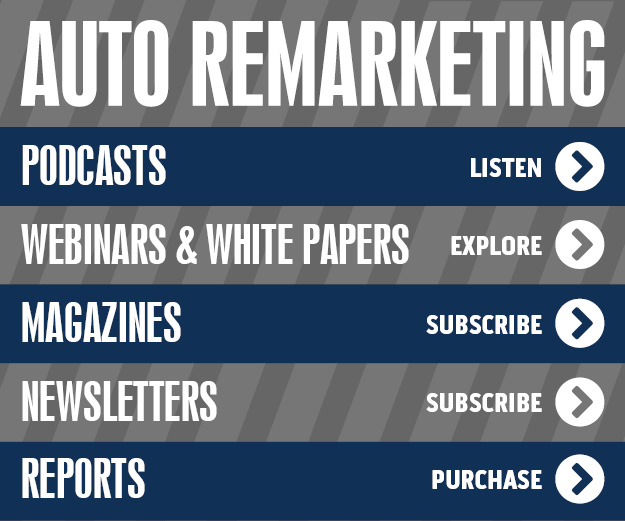Manheim Uncovers 2010 Trends in Mid-Year Market Report
ATLANTA — Wholesale pricing had been on an upward trajectory ever since the first quarter of 2009, but hit somewhat of a limit after reaching record levels in May, according to Manheim chief economist Tom Webb, who recently talked with Auto Remarketing to shed some more light on the company's mid-year edition of the 2010 Used Car Market Report.
The report — which is being released today and will available at www.manheim.com/consulting for sale Tuesdsay — examines a wide array of auto industry trends, including the used-vehicle market, dealers, as well as the rental, leasing and repossessions, commercial and government fleets, in addition to salvage segments.
Starting with the wholesale side of things, the Manheim Used Vehicle Value Index was at its highest-ever level in May, but wholesales prices have since stabilized.
Wholesale prices dipped "modestly" on a sequential basis in June, and the decline has been slightly more pronounced in July, Webb shared. Prices have fallen in the "neighborhood of 1 percent" month-over-month on a seasonally adjusted basis, he added.
June was up 5.3 percent from the prior-year period, and July will still likely show a year-over-year upswing, as well, he added.
The rest of the year will likely show declines in the index, but it will be more reflective of stabilization in wholesale prices, rather than a weak wholesale market.
"The index will be relatively strong if you look at it from a historical perspective, but I believe it will continue to decline," Webb predicted.
And there is some softness on the retail side of things when it comes to new- and used-vehicle sales, pricing and inventory turn rates, according to Webb. These factors, in turn, have led to some softness in the wholesale arena.
So what led to the increases in used pricing over the last year-and-half in the first place?
Webb said the "initial run-up" during the first quarter of last year was a "bounce-back" extremely weak numbers in 2008.
As 2009 wore on, however, overall conditions improved. There was a reduced wholesale supply that drove things at first, but, "as the year progressed we had improvement in retail demand."
But after hitting record levels in May, "it had run up about as much as it could," Webb noted, and things began to stabilize.
Sourcing Used Vehicles
Continuing on, Manheim's report indicates that dealers have ramped up their online auction participation as the shifting supply landscape has forced them to expand the methods in which they source used vehicles.
When asked about other ways dealers are finding used units beyond the Internet, Webb pointed out that dealers are more prone to hold onto trade-ins instead of selling them via auctions. In essence, dealers are much more interested in retailing units that in the past they would have wholesaled.
If a consumer brings in a trade-in, dealers are holding on to it to sell as retail "even if it's not the perfect fit."
Used-Vehicle Retail Sales
The report notes that 2010 will likely see used-vehicle sales in the neighborhood of 37 million units. Citing CNW Research data, Manheim pointed out that there was a 4.4-percent uptick in year-to-date used sales for dealers through June. Overall, retail used sales showed a 3.6-percent gain, with there being a 1.8-percent improvement in private-party sales.
The projected used total for full-year 2010 will likely end four straight years of eroding used sales, Manheim stressed.
"A lot of the reduction was driven by, number one, the severity of the recession, and number two, the lack of retail financing," Webb noted.
He pointed out a year of 40 million used sales is a more than "reasonable level."
"So, basically, we're back to where we should be," he shared.
New-Vehicle Market, More
Meanwhile, through June, the overall new-vehicle market (fleet and retail) was selling at an 11.1 million unit seasonally adjusted annualized rate. Part of the Manheim report examined the changes in the market's used-to-new ratio in recent years.
"Because of the tremendous fall-off in new-vehicle sales during the recession and the inherent greater stability in used-vehicle sales, the used-to-new sales ratio jumped from its normal 2.5-to-1 level during the past decade to 3.4-to-1 in 2009," Webb indicated.
For 2010, the ratio is expected to be 3.2-to-1. Though this is down from last year's proportion, Webb expects greater than a 3-to-1 ratio "for some time," thanks to the "dynamics of the industry."
"So, in terms of being on track with expectations, the retail used-vehicle market in the first half of 2010 has been pretty much in line, although a slightly higher level of total unit transactions would have been nice," Webb wrote in the report. "Blame the softness in used-vehicle sales on the weak new-vehicle market. After all, a retail new vehicle sale usually begets at least one used-vehicle sale in short order."
Auction Volumes
Moving back over to the wholesale market, auctions struggled on the sales front through June. Webb explained that unit sales saw an 8.2-percent dip when compared to the first six months of 2009, according to the National Auto Auction Association.
That said, Webb pointed out that auctions have made strides in other areas to make up ground.
"Auctions underperformed in units sold in the first half of 2010, but succeeded in increasing efficiency, instilling consistency and meeting customer needs," he wrote.
As far as the volume declines, Webb shared: "Commercial volumes fell slightly more than expected, and dealer consignment volumes rose less than expected. Again, blame the low level of retail new-vehicle sales."
Looking forward, he added: "Given that new-vehicle sales into fleet represent future wholesale volumes, whereas new-vehicle retail sales generate a more immediate impact, the prospects for auction volumes to grow in the second half of 20101 and into 2011 look good."
Editor's Note: To learn more about what Manheim revealed on the financial markets, including leasing and repos, stay tuned to SubPrime Auto Finance News.


